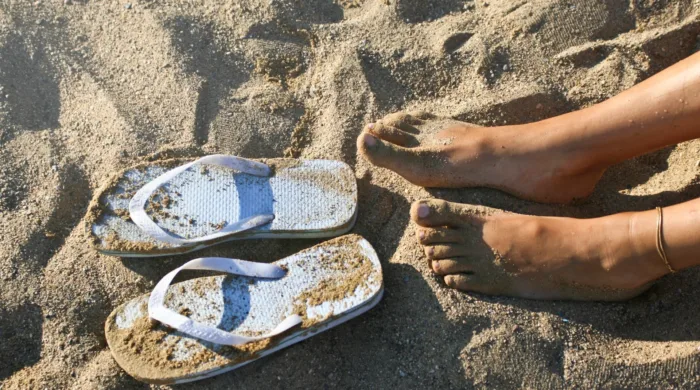With extensive options that offer various colors, treads, and materials, flip-flops have quickly become a staple of summertime footwear. While Flip-flops offer a budget friendly price tag and can be a fashionable, breathable addition to any shoe collection, we advise that you wear them in moderation and with caution.
What Are The Risks Of Flip-Flops?
For long time wear, flip-flops are not the ideal option. Because of their design and material, they present a number of risks if you wear them frequently, for long periods of time, or during the wrong activities. The risks include:
Puncture injury
Flip-flops are typically made of thin, spongy material (such as rubber or foam) that is easy to penetrate. Glass, nails, tacks, and other sharp objects can easily puncture flip-flops and cause injury to your feet.
Toe or foot injury
There is very little protection on the front or top portion of a flip-flop. Because of this, your risk of blunt force injury is increased. Some examples of toe or foot injury due to lack of protection include stubbing your toe, having your foot or toe stepped on, being injured from a falling object, or being burned by a hot liquid.
Plantar fasciitis
Flip-flops are flat, minimalistic footwear that can put stress on the arch of your foot and lead to inflammation of the tissue in your arch. This type of injury is called plantar fasciitis, and it presents itself as stabbing pain in the arch of your foot in the tissue that extends from the heel bone to the toes. Plantar fasciitis can lead to a number of other foot problems such as heel spurs, which will need to be treated by a Podiatrist.
Toe deformations
Flip-flops can cause or exacerbate conditions such as bunions, hammertoes, and corns. Because of the instability of flip-flops, your toes naturally flex and over grip to maintain contact with the flip-flop. This can cause toe deformations over time. Often, toe deformations are lasting and won’t heal or straighten out on their own.
Tendonitis
Tendonitis is caused by injury to the tendons in your foot due to overuse. It is painful and can cause stiffness and swelling in your foot and ankle.
Ankle injury
Due to the unsupportive nature of flip-flops, a misstep may cause your foot to over-rotate causing a fall, ankle sprain, or another type of ankle injury.
If you develop any of the above conditions or injuries, see a Podiatrist for evaluation and treatment of the issue.
Which Activities Are Unsafe In Flip-Flops?
Before putting on a pair of flip-flops, it’s always important to consider the activities that you plan to do while wearing them. Here are a few activities you shouldn’t do while wearing flip-flops.
- Do not engage in physical exercise
- Do not play sports
- Do not handle hot liquids
- Do not carry heavy objects
- Do not walk on uneven ground
- Do not be around machinery, tools, or motor vehicles
- Do not mow the lawn or yard work that may expose you to snakes, mosquitoes, sharp gardening tools, or other dangerous conditions
- Do not go hiking
- Do not drive. Flip-flops can easily get lodged underneath pedals and impair your ability to brake or accelerate.
- Do not wear them without applying sunscreen to your feet
- Do not wear them for long periods of time
It’s also important to consider the health of your feet. If you have diabetes, foot pain, are at risk of falling, or have a foot, ankle, or leg conditions, ditch your flip-flops and choose physician-approved supportive footwear instead. If you have back or neck pain, you may also find that flip-flops irritate your condition. When in doubt, talk to your physician and seek out a more supportive and customized alternative.
Now that we’ve discussed the potential risks associated with flip-flops, here are a few positive use cases.
When Should You Wear Flip-Flops?
While there are no direct benefits to flip-flops, if you have good foot health, it’s okay to wear flip-flops occasionally. Flip-flops can be appropriate when used as an alternative to bare feet, because they provide a protective buffer between you and the ground.
In this way, flip-flops can help you stay safe while:
- Walking on hot surfaces such as driveways, pavement, or sand.
- Walking on germy surfaces such as public showers or bathrooms.
- Sunbathing. They can help protect the bottoms of your feet from sunburn.
- Doing errands around the house. Getting your mail, washing your car.
As long as you’re using flip-flops as an alternative to bare feet and not walking in them for extended periods of time, flip-flops can be a fine, viable option for people with good foot health.
From all of us at WWMG, we urge you to consider more supportive footwear options whenever possible. If you do choose to keep flip-flops in your footwear rotation, always make sure they fit you properly and that you’re only wearing them on hard, flat surfaces. Opt for flip-flops with thick, durable soles, a thicker strap, and arch support. For more information on foot health, or if you are experiencing foot pain, contact our Podiatry department.
